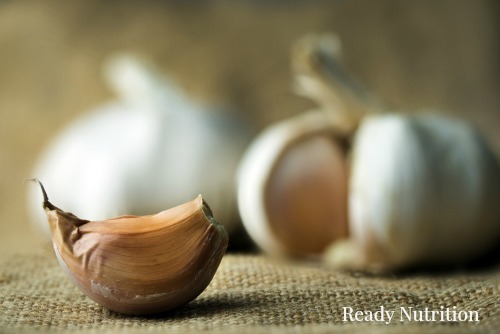Hey there, all of you guys and gals in Ready Nutrition Land! Are you ready for the second installment of the series on garlic? Well, ready or not, here it comes! The last episode we discussed many of the uses of garlic and its component parts that make it a “broad spectrum” herb. Before entailing the ways it is grown and stored, I wish to touch on a few more facts concerning its uses from a naturopathic standpoint.
Please keep in mind that this article is not meant to diagnose, treat, prescribe, cure, or take any action or activity from a medical perspective. This information is provided for informational purposes only. Prior to utilizing any of the information in this article, please consult with your licensed family physician for permission and approval.
Medicinal Uses For Garlic
Let us list some diseases that Garlic (Allium sativum) readily combats:
Staphylococcus aureus Pseudomonas aeruginosa Candida albicans
Escherichia coli Tuberculosis Shigella
Salmonella spp. Proteus mirabilis Herpes simplex
HIV Streptococcus spp. Tuberculosis
This list is not exhaustive. Garlic is effective against bacteria, viruses, as an antiseptic, an antiparasitic, against funguses, worms, and protozoans. The antibiotic activity in Garlic (as mentioned in the former article) originates with Allicin, and also diallyl disulfide, diallyl trisulfide, and ajoene (a substance created when allicin and diallyl disulfide combine). Preparations of fresh garlic are effective against both gram-negative and gram-positive bacteria. The juice of the herb diluted to a very small degree inhibits bacterial growth.
Garlic also stimulates the immune system and helps to lower the blood pressure (it thins the blood). It decreases the amount of cholesterol in the system. Any bacterial infection in the gastro intestines is negated as soon as raw garlic hits it. In terms of survival medicine, it is highly effective against E. coli, S. aureus, and others such as amebic dysentery and Cryptosporidium. All of these diseases become predominant/prevalent with the advent of a disaster, as freshwater supplies become contaminated. Please refer to my earlier articles on Waterborne Illnesses for more information on these pathogens and parasites.
Harvesting Garlic
Depending on your locale, Garlic is usually harvested in the autumn at the time that the leaves begin to dissipate and die off. Depending on your climate location, you may have to employ raised and/or covered beds. There are several different species that are very hardy and productive in a cold-weather climate. Rocambole is a type of garlic that is distinguishable by its reddish/purplish striations on the outer husk. Siberian and Korean varieties are especially hardy perennials that can withstand a tremendous cold.
You can use compost and mulched-soil-type beds and cover the ground surface of them with either straw or plastic bags (or a combination of the two), or use raised beds that are insulated on the walls with straw. The cloves should either be planted in the early fall or late summer. They will stay in the ground for the winter months and should be planted to a depth of about 2” maximum. Make sure they’re covered well! You don’t want them to be scorched by the freezing temperatures. They should be placed about 1 square foot apart on all sides to permit growth without each plant “stealing” the other plants’ nutrients.
The reason that it is so good to grow it is that it doesn’t require an inordinate amount of space and it is very “low maintenance” to grow such a wonderfully gifted herb that can become a mainstay to your herbal medicine chest. If you have a root cellar, all the better: for storage you can string the bulbs up and hang them to air dry. They will keep many months, either for direct use or for drying and powdering. Canning also works, especially in a water bath to preserve the allicin and component parts and lock it all inside of the jar.
Pretty simplistic to cultivate and harvest, it can be grown in pots and also planters. Once again, you must ensure your plants receive adequate water every couple of days without overwatering, as this can lead to rot. The herb is good to use against virtually any disease or infection. As far as drying is concerned, it may not be cost-effective to use with a standard dehydrator; however, if you build your own system to utilize sun drying in your dehydration, this is probably the optimal level for your activities.
It is a simple thing to backpack with a small container of powdered garlic with you, and for longer, extended trips, you may wish to take a small jar of crushed garlic stored in water with you. Garlic has been used for more than five thousand years as a broad-spectrum herb, and do you know why? It works! You can cultivate and grow it, store it, and use it against a variety of illnesses. It is very good for you and a way to fight infections that do not have an abundance of side effects that may affect your system negatively. For a survival and SHTF herb, it can’t be topped. Have a good day, and remember garlic as a survival herb: it’s not just to flavor food!
JJ
This article was originally published at Ready Nutrition™ on July 13th, 2015







